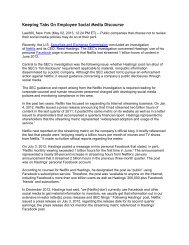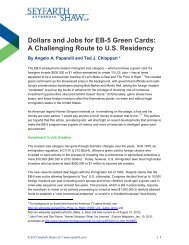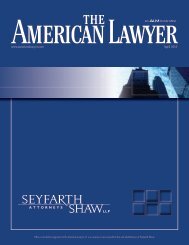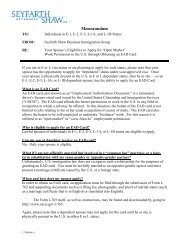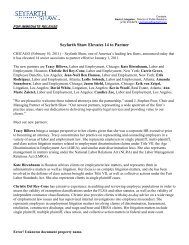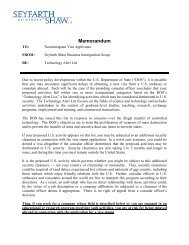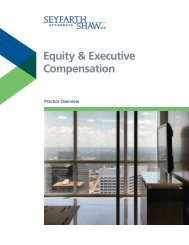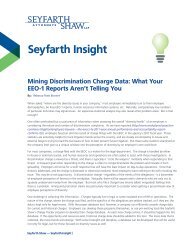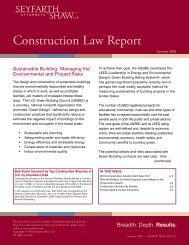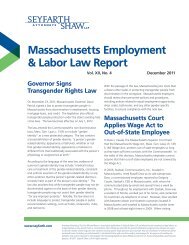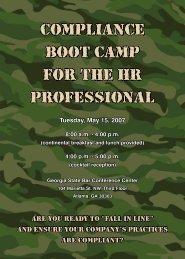Litigating California Wage & Hour and Labor Code Class Actions
Litigating California Wage & Hour and Labor Code Class Actions
Litigating California Wage & Hour and Labor Code Class Actions
You also want an ePaper? Increase the reach of your titles
YUMPU automatically turns print PDFs into web optimized ePapers that Google loves.
compensation expenses. The plaintiffs argued that if these workers’ compensation<br />
expenses were factored into the net profit calculation, then any reduction in bonus to<br />
account for increased workers’ compensation expenses plainly violated Section 3751, just<br />
as a bonus taking cash shortages into account violated Section 8 of the <strong>Wage</strong> Orders, as<br />
interpreted by Kerr’s Catering. At least one appellate decision agreed that net profits based<br />
calculations ran afoul of Section 3751. 65<br />
After several years in which many bonus plan class actions were filed, the <strong>California</strong><br />
Supreme Court effectively put an end to them in 2007 with the issuance of Ralphs II, 66 the<br />
Court held that traditional net-profits-based bonus systems are lawful in <strong>California</strong> <strong>and</strong> are<br />
not the functional equivalent of a scheme to deduct from employee’s wages on improper<br />
bases.<br />
The <strong>California</strong> Supreme court distinguished earlier cases that invalidated bonus plans that<br />
tied a bonus or commission to an employee’s individual sales effort, but which then<br />
reduced the bonus amount to cover employer costs. Under those types of bonus plans,<br />
employers used the bonus as an artifice to hide the fact that they were charging employees<br />
on a dollar-for-dollar basis for losses to the company <strong>and</strong> merely hid the deduction in the<br />
calculation of the so-called “bonus.” 67<br />
By contrast, “the [Ralphs plan] did not create an expectation or entitlement in a specified<br />
wage, then take deductions or contributions from that wage to reimburse Ralphs for its<br />
business costs.” Each Ralphs store employee received a guaranteed dollar wage, which<br />
was paid regardless of a store’s profit or loss for a specified period. Under the Ralphs<br />
bonus plan, employees were entitled to a supplementary incentive compensation payment<br />
“only after the store had completed the relevant period of operation” <strong>and</strong> the resulting profit<br />
or loss figure was calculated. This final figure “was the amount offered or promised as<br />
compensation for labor performed by eligible employees, <strong>and</strong> it thus represented their<br />
supplemental ‘wages’ or ‘earnings.’” Therefore, the amount “offered or promised as<br />
compensation for labor performed” already accounted for the deductions about which the<br />
plaintiff complained. 68<br />
Accordingly, the Ralphs plan did not illegally shift business losses to employees. Rather, it<br />
provided supplemental compensation the company used to “encourage <strong>and</strong> reward certain<br />
employees’ cooperative <strong>and</strong> collective contributions to the profitable performance of their<br />
65<br />
66<br />
67<br />
68<br />
Ralphs I, 112 Cal. App. 4th at 1104-5.<br />
42 Cal. 4th 217 (2007).<br />
See, e.g., Quillian, 96 Cal. App. 3d 156 (1970) (manager received bonus calculated as a percentage of store sales<br />
minus the dollar value of any cash shortages during the bonus period).<br />
42 Cal. 4th at 229.<br />
Seyfarth Shaw LLP | www.seyfarth.com <strong>Litigating</strong> <strong>California</strong> <strong>Wage</strong> & <strong>Hour</strong> <strong>Class</strong> <strong>Actions</strong> (12th Edition) 20



